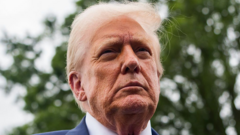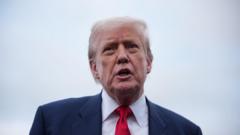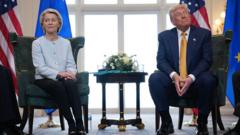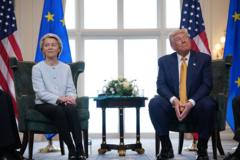The executive order aims to reduce US drug prices by ensuring companies adhere to foreign pricing standards, but experts express doubts about its impact and potential challenges from the pharmaceutical industry.
**Trump's Executive Order Aims to Slash Drug Prices: Will It Live Up to the Hype?**

**Trump's Executive Order Aims to Slash Drug Prices: Will It Live Up to the Hype?**
US President Donald Trump announces a sweeping executive order targeting high prescription drug costs, yet skepticism looms over its effectiveness.
In a bold maneuver to tackle soaring prescription drug costs, President Donald Trump has implemented an executive order that he claims will significantly lower prices for Americans, aligning them with prices seen in other countries. This ambitious initiative has reignited discussions around why the United States consistently faces higher pharmaceutical costs compared to other developed nations, such as Canada and Australia.
Trump's administration asserts that patients in the US pay exorbitant prices for medications while people in other countries benefit from lower costs due to more regulated healthcare systems. During the announcement, Trump heralded the order as potentially one of the most impactful in US history, suggesting it could lead to price drops ranging from 30% to 80% almost immediately.
However, the expert community remains dubious about the reality of such dramatic reductions. As data shows, drug prices in the US can be two to four times higher than those in other countries. This disparity can be attributed to the intricate web of the US healthcare system, which features a mix of private insurance, government programs like Medicare and Medicaid, and varying degrees of pharmaceutical lobbying.
Among the key elements of Trump's order is the implementation of "Most Favoured Nation" (MFN) status, which would require drug companies to offer their lowest foreign prices to American consumers. The President pledged to eliminate practices that allow pharmaceutical firms to impose "unreasonable or discriminatory" price hikes. However, many are left pondering how these protections will be enforced and the actual meaning of "unreasonable" within this context.
Additionally, Trump intends to enhance market access by promoting direct sales between drug companies and consumers, potentially bypassing insurance companies and pharmacy benefit managers. Yet, such a move encounters challenges concerning safety regulations and trade laws regarding importing drugs from nations where they are sold at a fraction of the cost in the US.
As the stock market's reaction showed optimism among major pharmaceutical companies, experts are quick to point out that the industry may adapt its strategies to mitigate potential losses, possibly pulling out of segments where they currently offer lower prices. Moreover, analysts have expressed concern that importing lower-priced drugs could detrimentally impact American health outcomes long-term, highlighting that a European pricing model might not align with the US's unique healthcare needs.
While public sentiment has been rooted in frustration regarding high drug prices, Trump's order faces expected legal challenges from industry players, which argue that these regulations could stifle drug development and availability, arguing that employing discounted foreign pricing models from "socialist countries" would ultimately harm American patients.
Despite the immediate disruption suggested by Trump's order, experts caution that the administration's commitment to sustaining momentum on this issue remains uncertain. Should there be continued focus and action to enforce lower prices through transparency and regulatory measures, it could signal a shift. Nevertheless, as one Boston University professor articulated, whether this will lead to significant, sustainable changes in the pricing landscape of American pharmaceuticals remains to be seen.
Trump's administration asserts that patients in the US pay exorbitant prices for medications while people in other countries benefit from lower costs due to more regulated healthcare systems. During the announcement, Trump heralded the order as potentially one of the most impactful in US history, suggesting it could lead to price drops ranging from 30% to 80% almost immediately.
However, the expert community remains dubious about the reality of such dramatic reductions. As data shows, drug prices in the US can be two to four times higher than those in other countries. This disparity can be attributed to the intricate web of the US healthcare system, which features a mix of private insurance, government programs like Medicare and Medicaid, and varying degrees of pharmaceutical lobbying.
Among the key elements of Trump's order is the implementation of "Most Favoured Nation" (MFN) status, which would require drug companies to offer their lowest foreign prices to American consumers. The President pledged to eliminate practices that allow pharmaceutical firms to impose "unreasonable or discriminatory" price hikes. However, many are left pondering how these protections will be enforced and the actual meaning of "unreasonable" within this context.
Additionally, Trump intends to enhance market access by promoting direct sales between drug companies and consumers, potentially bypassing insurance companies and pharmacy benefit managers. Yet, such a move encounters challenges concerning safety regulations and trade laws regarding importing drugs from nations where they are sold at a fraction of the cost in the US.
As the stock market's reaction showed optimism among major pharmaceutical companies, experts are quick to point out that the industry may adapt its strategies to mitigate potential losses, possibly pulling out of segments where they currently offer lower prices. Moreover, analysts have expressed concern that importing lower-priced drugs could detrimentally impact American health outcomes long-term, highlighting that a European pricing model might not align with the US's unique healthcare needs.
While public sentiment has been rooted in frustration regarding high drug prices, Trump's order faces expected legal challenges from industry players, which argue that these regulations could stifle drug development and availability, arguing that employing discounted foreign pricing models from "socialist countries" would ultimately harm American patients.
Despite the immediate disruption suggested by Trump's order, experts caution that the administration's commitment to sustaining momentum on this issue remains uncertain. Should there be continued focus and action to enforce lower prices through transparency and regulatory measures, it could signal a shift. Nevertheless, as one Boston University professor articulated, whether this will lead to significant, sustainable changes in the pricing landscape of American pharmaceuticals remains to be seen.





















